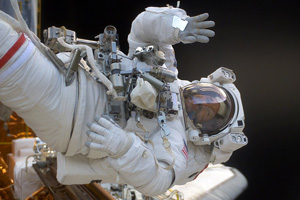- STS-67, Endeavor, March 1995: This was the second flight of the Astro observatory, a complement of three ultraviolet telescopes. The crew, including mission specialist Grunsfeld, conducted around-the-clock observations of faint astronomical objects and ultraviolet light coming from hot stars and distant galaxies.
- STS-81, Atlantis, January 1997: This was the fifth mission to dock with Russia’s Space Station Mir, and the second to exchange U.S. astronauts. Grunsfeld served as flight engineer.
- STS-103, Discovery, December 1999: During this mission, the crew installed new gyroscopes and scientific instruments and upgraded systems on the Hubble Telescope. Grunsfeld performed two spacewalks totaling 16 hours and 23 minutes.
- STS-109, Columbia, March 2002: The crew upgraded the Hubble Space Telescope, installing a new digital camera, a cooling system for the infrared camera, new solar arrays and a new power system. Grunsfeld served as the payload commander in charge of spacewalking activities and the Hubble payload, as he will for the next mission. He performed three spacewalks totaling 21 hours and 9 minutes.
Veteran space walker could find three-point line during Hubble Space Telescope mission
By Steve Koppesskoppes@uchicago.edu
News Office
 Photos courtesy of NASA’s Human Spaceflight Collection Astronauts John Grunsfeld (top) and Richard Linnehan participated in a six-hour, 48-minute space walk in 2002 designed to install a new Power Control Unit on the Hubble Space Telescope. The two went on to replace the original unit launched with the telescope in April 1990. Grunsfeld is on the end of Columbia’s Remote Manipulation System robotic arm, controlled from inside the crew cabin by astronaut Nancy Currie. The image was recorded with a digital still camera. Grunsfeld, the payload commander (below), waves at a crewmate inside Space Shuttle Columbia’s crew cabin during a brief break in work on the telescope. |
|
 |
|
Even Michael Jordan’s Chicago Bulls would find it impossible to match the star power of the Chicago Maroons’ Big Ten champion basketball teams of 1907-08 and 1908-09. Playing forward for the Maroons during those seasons was a 6-foot-2-inch undergraduate named Edwin Hubble.
Most people know Hubble (S.B.,1910, Ph.D.,1917) as a famed astronomer, the namesake of the orbiting Hubble Space Telescope. But as an athlete he also helped the Maroons post records of 24-2 in 1907-08 and 10-3 in 1908-09. There was no post-season tournament back then, but the Helms Athletic Foundation assembled a panel of experts that retroactively named the Maroons national champions both years.
“It illustrates that scientists are people too, and that a great scientist can be a great athlete,” said Michael Turner, the Bruce V. and Diana M. Rauner Distinguished Service Professor in Astronomy & Astrophysics and the College.
Now another Chicago alumnus, astronaut John Grunsfeld (S.M.,’84, Ph.D.,’88), will fly into orbit a century-old basketball that Hubble tossed around in a 1909 victory against Indiana University. The space shuttle Atlantis is scheduled to launch Tuesday, May 12, which will be Grunsfeld’s third mission to refurbish and upgrade the Hubble Telescope.
“Chicago has always been at the forefront of exploration through the Laboratory for Astrophysics and Space Research, South Pole research and so much more,” Grunsfeld said.
Grunsfeld had borrowed the basketball from the Department of Physical Education and Athletics, with Turner serving as intermediary, so that he could fly it into orbit. He plans to return the basketball personally to the University after the mission, when it will go on display at the Gerald Ratner Athletics Center.
Grunsfeld grew up near the University’s campus on Chicago’s South Side, where Nobel laureate Enrico Fermi oversaw construction of the first nuclear reactor during World War II.
“I was inspired as a young man by the exploits of Enrico Fermi as a scientist and as a mountaineer in the Dolomites, and he became a role model for me,” said Grunsfeld, who studied physics at Chicago.
Before joining NASA in 1992, he had amassed research experience in X-ray and gamma-ray astronomy, high-energy cosmic ray studies and the development of new detectors and instrumentation. Grunsfeld has since used the Hubble Telescope in his own research. As NASA’s chief scientist from 2003 to 2004, Grunsfeld helped develop the President’s Vision for Space Exploration.
During his four previous space flights, he logged more than 45 days in space, including five spacewalks totaling more than 32 hours:
“It’s been a glorious career, and I’ve been incredibly privileged to fly in space and to work on the Hubble Space Telescope,” Grunsfeld said.
![[Chronicle]](/images/sidebar_header_oct06.gif)